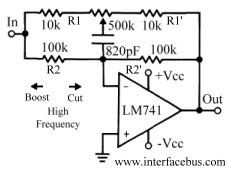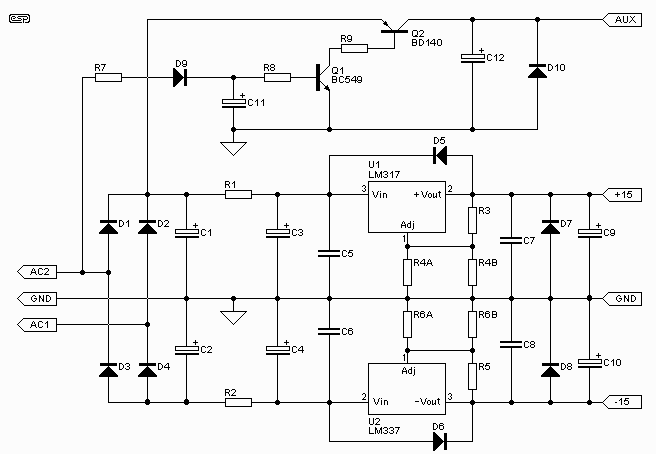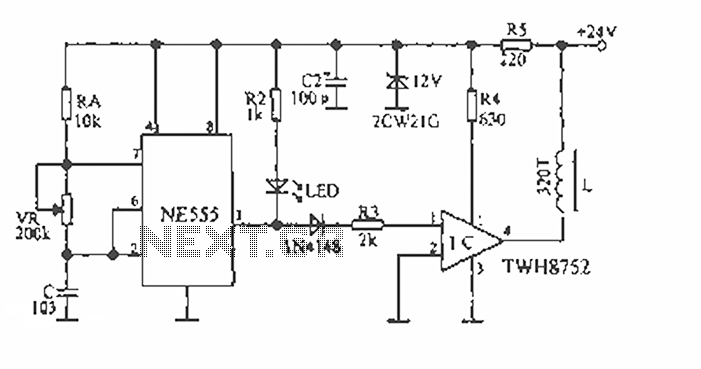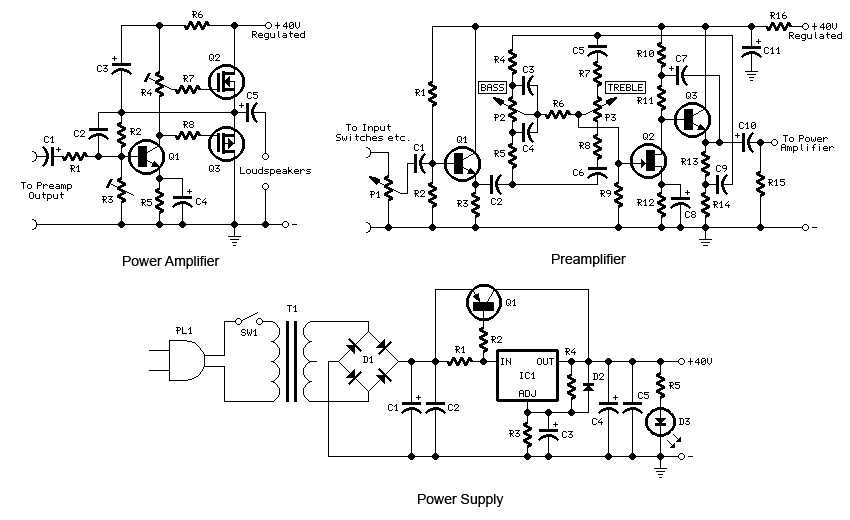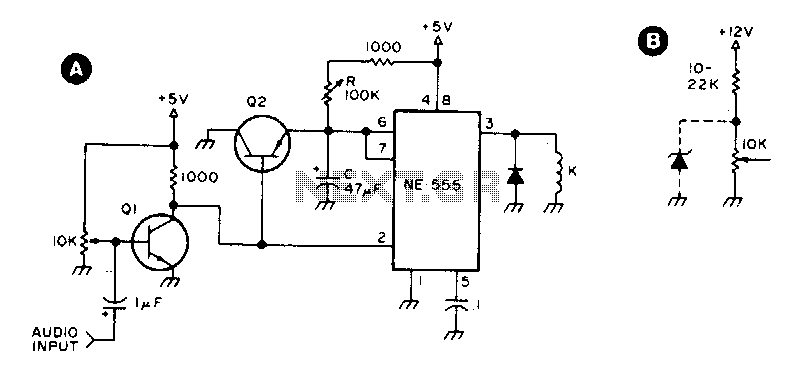
Portable Audio Amplifiers (TEA2025)
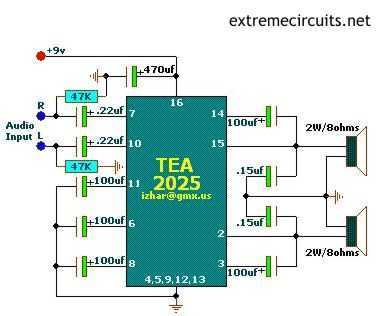
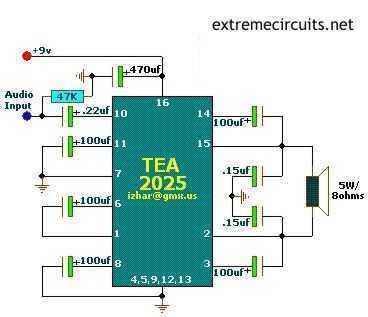
The above circuits are based on TEA2025, a monolithic integrated audio amplifier in a 16-pin plastic dual in-line package manufactured by UTC. The circuit has an internal thermal protector and is designed for portable cassette players and radios. It can also be used as a PC audio amplifier. A few external components are required to build this circuit. Use a 9V transformer to power the circuit, but do not exceed DC12V, as this can damage the amplifier IC.
Stereo per channel:
VCC=9V; RL=4Ω/3W
VCC=9V; RL=8Ω/2W
Bridge Application:
VCC=9V; RL=8Ω/5W
VCC=9V; RL=4Ω/8W
Supply Voltage min = DC3V @ 500mA
Supply Voltage max = DC12V @ 500mA
Supply Voltage recommended = DC9V @ 500mA
The TEA2025 audio amplifier is designed to provide high-quality audio output with minimal external components, making it suitable for various applications, including portable audio devices and personal computers. The internal thermal protection feature safeguards the IC from overheating, ensuring reliable operation under varying load conditions.
In stereo configuration, the amplifier can operate with a supply voltage of 9V, delivering 3W output power into a 4Ω load and 2W into an 8Ω load. These specifications indicate that the TEA2025 is capable of driving small speakers effectively, making it ideal for compact audio systems.
For bridge applications, the TEA2025 can also be configured to deliver higher output power. In this setup, it can provide 5W into an 8Ω load and 8W into a 4Ω load, which is beneficial for applications requiring more robust audio performance, such as driving larger speakers.
The recommended operating voltage for optimal performance is 9V at 500mA, which balances power output and thermal efficiency. Operating the amplifier at voltages below 3V may lead to insufficient performance, while exceeding 12V can risk damaging the IC.
In summary, the TEA2025 is a versatile audio amplifier suited for various applications, with specific configurations available for stereo and bridge modes, catering to different load impedances and power requirements. Proper attention to the supply voltage specifications is crucial for maintaining the integrity and longevity of the device.The Above circuits are based on TEA2025 is a monolithic integrated audio amplifier in a 16-pin plastic dual in line package manufactured by UTC .Circuit has an Internal Thermal Protector. It is designed for portable cassette players and radios. You can also use it as your PC Audio Amplifier. A few external components required to build this circuit. Use 9v transformer to play the circuit. But not more than DC12v. Because it can damage the amplifier IC. Stereo per channel VCC=9V;RL=4?/3W VCC=9V;RL=8?/2W Bridge Application VCC=9V;RL=8?/5W VCC=9V;RL=4?/8W Supply Voltage min = DC3v @ 500mA Supply Voltage max = DC12v @ 500mA Supply Voltage recommended = DC9v @500mA 🔗 External reference
Stereo per channel:
VCC=9V; RL=4Ω/3W
VCC=9V; RL=8Ω/2W
Bridge Application:
VCC=9V; RL=8Ω/5W
VCC=9V; RL=4Ω/8W
Supply Voltage min = DC3V @ 500mA
Supply Voltage max = DC12V @ 500mA
Supply Voltage recommended = DC9V @ 500mA
The TEA2025 audio amplifier is designed to provide high-quality audio output with minimal external components, making it suitable for various applications, including portable audio devices and personal computers. The internal thermal protection feature safeguards the IC from overheating, ensuring reliable operation under varying load conditions.
In stereo configuration, the amplifier can operate with a supply voltage of 9V, delivering 3W output power into a 4Ω load and 2W into an 8Ω load. These specifications indicate that the TEA2025 is capable of driving small speakers effectively, making it ideal for compact audio systems.
For bridge applications, the TEA2025 can also be configured to deliver higher output power. In this setup, it can provide 5W into an 8Ω load and 8W into a 4Ω load, which is beneficial for applications requiring more robust audio performance, such as driving larger speakers.
The recommended operating voltage for optimal performance is 9V at 500mA, which balances power output and thermal efficiency. Operating the amplifier at voltages below 3V may lead to insufficient performance, while exceeding 12V can risk damaging the IC.
In summary, the TEA2025 is a versatile audio amplifier suited for various applications, with specific configurations available for stereo and bridge modes, catering to different load impedances and power requirements. Proper attention to the supply voltage specifications is crucial for maintaining the integrity and longevity of the device.The Above circuits are based on TEA2025 is a monolithic integrated audio amplifier in a 16-pin plastic dual in line package manufactured by UTC .Circuit has an Internal Thermal Protector. It is designed for portable cassette players and radios. You can also use it as your PC Audio Amplifier. A few external components required to build this circuit. Use 9v transformer to play the circuit. But not more than DC12v. Because it can damage the amplifier IC. Stereo per channel VCC=9V;RL=4?/3W VCC=9V;RL=8?/2W Bridge Application VCC=9V;RL=8?/5W VCC=9V;RL=4?/8W Supply Voltage min = DC3v @ 500mA Supply Voltage max = DC12v @ 500mA Supply Voltage recommended = DC9v @500mA 🔗 External reference
